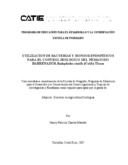Utilización de bacterias y hongos endofíticos para el control biologico del nematodo barrenador Radopholus similis (Cobb) Thorn

View/
Date
2007Author
Chaves Méndez, Nancy P.
Type
Tesis de maestría
Metadata
Show full item recordAlternative title
Utilization of endophytic bacteria and fungi for the biological control of the burrowing nematode Radopholus similis (Cobb) Thorn
Description
25 ilus. 18 tab. 43 ref. Tesis (Mag. Sc) -- CATIE, Turrialba (Costa Rica), 2007
Abstract
Ocho aislamientos endofíticos con conocida actividad antagonista contra Radopholus imilis fueron estudiados en condiciones in vivo e in vitro para determinar su compatibilidad, así como su efecto, tanto individual como combinado, sobre el biocontrol de R. similis y en la promoción de crecimiento de vitroplantas de banano del cultivar "Gran Enano" en invernadero. No se econtraron casos de incompatibilidad en las combinaciones hongo-bacteria y bacteria-bacteria en ninguno de los ensayos realizados. Las bacterias presentaron un mayor número de ufc/ml y potencial de inóculo en comparación con los hongos. Asímismo, en todas las combinaciones hongo-bacteria y bacteria-bacteria, las bacterias presentaron un crecimiento más rápido y mayor porcentaje de colonización en la planta independientemente del órgano estudiado. La penetración de R. similis en el sistema radical fue significativamente menor en plantas protegidas con inoculaciones mixtas en comparación con la inoculación individual de los agentes biológicos y el testigo aboluto. Adicionalmente, se encontró que la combinación de los agentes de biocontrol presentó mejor efecto en la reducción de la población final de R. similis en el sistema radical, en comparación con la inoculación de cada agente por separado, con diferencias altamente significatias con respecto al testigo referencial. Veintiún tratamientos presentaron actividad antagonista estadísticamente similar al testigo químico, con porcentajes de biocontrol entre 62 y 93 por ciento. El efecto aditivo y/o sinérgico de los mecanismos de acción de los agentes biológicos quedó demostrado en su actividad antagonista contra R. similis. Además, los resultados obtenidos en el bioensayo de promoción de crecimiento demostraron que plantas protegidas con inoculaciones múltiples presentaron valores mayores en las variables peso total de la planta, peso radical y longitud radical en comparación con las inoculaciones individuales y los testigos. Eight endophytic fungal and bacterial isolates with well-known antagonistic activity against Radopholus similis were evaluated under in vivo and in vitro conditions to determine their compatibility as well as their individual and combined effects on the biocontrol of R. similis and on the growth promotion of "Grand Naine" cultivar plantlets in the glasshouse. No evidence of fungi-bacteria or bacteria-bacteria incompatibility was observed. However, bacterial endophytes grew much faster than their fungal counterparts, and in all endophyte combinations observations showed that the bacterial component had a higher percentage of tissue colonization. Nematode penetration of the root system was significantly lower in plantlets protected with mixed than single endophyte inoculum. In addition, combinations of biocontrol agents induced a highly significant reduction in the final nematode population of roots when compared with the reference control. Twenty-one treatments produced antagonistic activity which was statistically similar to the nematicide control, with biocontrol percentages ranging between 62 and 93 percent. The additive or synergistic effects of the biocontrol agents were demonstrated by their antagonistic activity against R. similis. In addition, the growth promotion bioassay showed that plants protected with mixed inocula increased root length and gave a higher weight of plant and root biomass in comparison with single entophyte inocula and the absolute control.
Keywords
Asesor
Pocasangre, Luis
Publisher
CATIE, Turrialba (Costa Rica)
Is part of
Magister Scientiae en Agricultura Ecológica
URI (Permanet link to cite or share this item)
https://repositorio.catie.ac.cr/handle/11554/5635Collections
- Tesis [2820]

